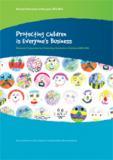Protecting Children is Everyone’s Business: National Framework for Protecting Australia’s Children 2009–2020 – Second Action Plan 2012–2015
Aim of publication
The Council of Australian Governments endorsed the National Framework for Protecting Australia’s Children 2009-2020 (the National Framework) on 30 April 2009. The National Framework is being implemented through a series of three-year action plans. The First Action Plan (2009‑2012) delivered a firm foundation for the National Framework through strong collaboration across all governments and the non-government sector and by building the evidence base for future actions to protect children and families at-risk. The Second Action Plan (2012–2015) outlines how all governments, the non-government sector and the broader community will progress actions during the next three years of the National Framework to ensure that Australia’s children grow up safe and well. The Second Action Plan was developed through close collaboration between the Commonwealth, State and Territory governments, and the non-government sector, through the Coalition of Organisations Committed to the Safety and Wellbeing of Australia’s Children. This approach reflects the National Framework’s key message that ‘protecting children is everyone’s business’.
Who is it for?
Under the National Framework, protecting children is everyone’s business. The Second Action Plan is for Commonwealth, State and Territory governments, non‑government organisations, service providers and individuals with an interest in ensuring Australia’s children are safe and well.
What does it cover?
The critical focus of the Second Action Plan is ‘working together’ across government and non‑government sectors, including engaging with sectors that are not traditionally thought of as child centred, to raise awareness and address risk factors for abuse and neglect. It will also emphasise the development of local partnerships for local solutions, recognising that a ‘one size fits all’ approach does not work across Australia’s diverse communities and that Aboriginal and Torres Strait Islander and culturally and linguistically diverse families and communities need strategies that are sensitive to their needs and circumstances.
Last updated:

